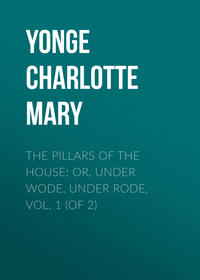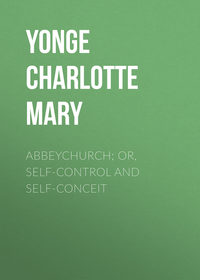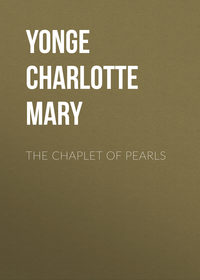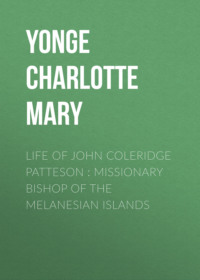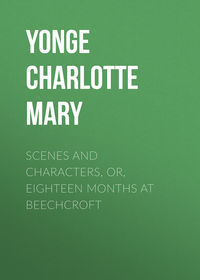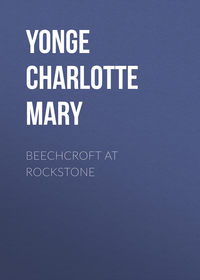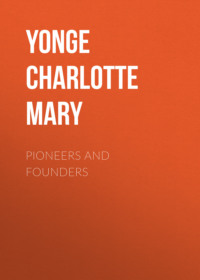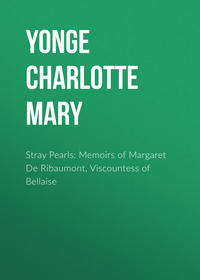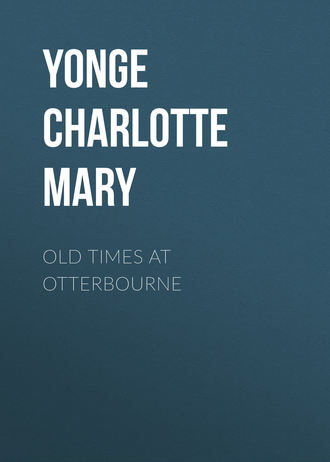 полная версия
полная версияOld Times at Otterbourne
His kindness and simplicity were sometimes abused. He never had the heart to refuse to lend money, or to deny bread on credit to hopeless debtors; and altogether debts, distress, baking all night, and school keeping all day, were too much for him. The first hint of an examination of his school completed the mischief, and he died insane. It is a sad story, but many of us will remember with affectionate regard the good, kind, quaint, and most excellent little man. By that time our schoolmistress was Mrs. Durndell, the policeman’s wife, a severe woman, but she certainly made the girls do thoroughly whatever she taught, especially repetition and needlework.
The examiner on religious subjects, Mr. Allen, afterwards an Archdeacon, reported that the girls had an unusual knowledge of the text of Scripture, but that he did not think them equally intelligent as to the meaning.
Daily Service had been commenced when the new Church was opened, and the children of the schools attended it. There was also a much larger congregation of old men than have ever come in later years. At one time there were nine constantly there. One of these, named Passingham, who used to ring the bell for matins and evensong, was said to have been the strongest man in the parish, and to have carried two sacks of corn over the common on the top of the hill in his youth. He was still a hearty old man at eighty-six, when after ringing the bell one morning as usual, he dropped down on the hill in a fit and died in a few seconds.
There was not much change for a good many years. In 1846, the Parsonage House was built and given to the living by Mr. Keble. The stained glass of the south window of the Church was given by the Reverend John Yonge, of Puslinch, Rector of Newton Ferrers, in Devonshire, in memory of his youngest son, Edmund Charles, who died at Otterbourne House in 1847. Thirteen years previously, in 1834, the eldest son, James Yonge, had likewise died at Otterbourne House. Both the brothers lie buried here, one in the old churchyard, one in the new. They are commemorated in their own church at Newton by a tablet with the inscription—“What I do thou knowest not now, but thou shall know hereafter.”
In 1834 their father gave what made, as it were the second foundation of the Lending Library, for there were about four-and-twenty very serious books, given in Archdeacon Heathcote’s time, kept in the vestry at the old Church. They looked as if they had been read but only by the elder people who liked a grave book, and there was nothing there meant for the young people. So there were a good many new books bought, and weekly given out at the Penny Club, with more or less vigour, for the next thirty years or so.
The next public matter that greatly affected this place was the Crimean War. It was a large proportion of our young men who were more or less concerned in it. Captain Denzill Chamberlayne in the Cavalry, Lieut. Julian B. Yonge, John Hawkins, Joseph Knight, James and William Mason, and it was in the midst of the hurry and confusion of the departure that the death of Mr. W. C. Yonge took place, February 26th, 1854. Three of those above mentioned lived to return home. Captain Chamberlayne shared in the famous charge of the Light Brigade, at Balaclava, when
Into the jaws of deathRode the six hundred:Cannon to right of them,Cannon to left of them,Volleyed and thundered.His horse, Pimento, was killed under him, but he escaped without a wound, and on his return home was drawn up to the house by the people, and had a reception which made such an impression on the children that when one was asked in school what a hero was, she answered, “Captain Chamberlayne.”
John Hawkins, Joseph Knight, and William Mason died in the Crimea. A tablet to commemorate them was built into the wall of the churchyard, with the text—“It is good for a man that he bear the yoke in his youth,” for the discipline of the army had been very good for these youths, and, therefore, this verse was chosen for them by Mr. Keble.
The next event that concerned the parish much was the death of the great and holy man who had been our rector for thirty years. Mr. Keble died at Bournemouth on the 29th of March, 1866. His manners and language were always so simple, and his humility so great, that many of those who came in contact with him never realized how great a man he was, not being able to perceive that the very deepest thoughts might be clothed in the plainest language. Some felt, in the words of the poem,—
“I came and saw, and having seen, Weak heart! I drew offenceFrom thy prompt smile, thy humble mien, Thy lowly diligence.”But none who really knew him could fail to be impressed with the sense of his power, his wisdom, his love, and, above all, his holiness; and his Christian Year will always be a fund of consolation, full of suggestions of good and devotional thoughts and deeds. Mrs. Keble, who was already very ill, followed him to her rest on the 11th of May. It may be worth remembering that the last time she wrote her name was a signature to a petition against licensing marriage with a deceased wife’s sister.
Sir William Heathcote then appointed the Reverend James G. Young as Vicar of Hursley and Otterbourne. A fresh tide of change began to set in. As times altered and population increased, and as old things and people passed away, there were various changes in the face of the village. The Government requirements made it necessary to erect a new Girl’s School, and land was permanently secured for the purpose, and this was done chiefly by subscription among the inhabitants, affording a room large enough for parish meetings and lectures, as well as for its direct purpose. The subscription was as a testimonial to the Rev. William Bigg-Wither, who had been thirty years curate of the parish, and under whom many of the changes for the better were worked out. The building was provided with a tower, in case there should ever be a clock given to the parish.
The clock was given in a manner worthy of remembrance. Mr. William Pink, as a thatcher, and his two sisters in service, had saved enough to provide for their old age, and to leave a considerable overplus, out of which the last survivor, Mrs. Elizabeth Pink, when passing away at a good old age, bequeathed enough to provide the parish with the clock whose voice has already become one of our most familiar sounds.
Allbrook was by this time growing into a large hamlet, and a school chapel was then built, chiefly by Mr. Wheeler. We must not forget that we had for five years the great and excellent Samuel Wilberforce for our Bishop, and that he twice held confirmations in our parish. No one can forget the shock of his sudden call. One moment he was calling his companion’s attention to the notes of a late singing nightingale; the next, his horse had stumbled and he was gone. It was remarkable that shortly before he had, after going over the hospital, spoken with dread of what he called the “humiliation of a lingering illness”—exactly what he was spared.
Bishop Harold Browne came from Ely to take the See of Winchester. He reconsecrated our church when the chancel was enlarged and the new aisle added. He carried on vigorously work only begun under Bishop Wilberforce. Under him Diocesan Synods, the Girls’ Friendly Society, and the Examination of Senior Scholars in Religious Knowledge have all shown his diligent oversight as Shepherd of the flock.
In the year 1875 Sir William Heathcote succeeded in bringing about an arrangement by which Otterbourne could be separated from Hursley and have a Vicar of its own, the difference of income being made up to the Vicar of Hursley. This was done by the aid of a munificent lady, Mrs. Gibbs, the widow of one of the great merchant princes, whose wealth was always treated as a trust from God. She became the patron of the living, and the advowson remains in her family.
The first Vicar was the Reverend Walter Francis Elgie, who had already been six years curate, and had won the love and honour of all his flock. Deeply did they all mourn him when it was God’s will to take him from them on the 25th of February, 1881, in the 43rd year of his age, after ten years of zealous work.
It was felt as remarkable that a young pupil teacher in consumption, whom he had sent to the Home at Bournemouth, was taken on the same day, and buried here the day after, and that the schoolmaster, Walter Fisher, a man of gentle and saintly nature, followed him six weeks after.
We left them in the Church’s shade, Our standard-bearer true,And near at hand the gentle maid Who well his guidance knew.He fainted in the noon of life, Nor knew his victory won;She was fresh girded for the strife, Her battle scarce begun.Long had we known Death’s angel hand The maiden’s brow had seal’d;He fell, like chief of warrior band, Struck down on battle-field.So in God’s acre here they meet As they have met above,Tasting beneath their Saviour’s feet The treasures of His love.For what they learnt and taught of here Is present with them there;May we speed on in faith and fear, Then heavenly rest to share.With the coming of our present Vicar, the Rev. H. W. Brock, our Otterbourne story ends, as the times are no longer old times. The water works for the supply of Southampton are our last novelty, by which such of us benefit, as either themselves or their landlords pay a small contribution. They have given us some red buildings at one end and on the Hill a queer little round tower containing the staircase leading to the underground reservoir, a wonderful construction of circles of brick pillars and arches, as those remember who visited it before the water was let in. And, verily, we may be thankful that our record has so few events in it, no terrible disasters, but that there has been peace and health and comfort, more than falls to the lot of many a parish. Truly we may thankfully say, “The lot is fallen unto me in a fair ground, yea, I have a goodly heritage.”

Old Remembrances.

I remember, I remember,
Old times at Otterbourne,
Before the building of the Church,
And when smock frocks were worn!
I remember, I remember,
When railroads there were none,
When by stage coach at early dawn
The journey was begun.
And through the turnpike roads till eve
Trotted the horses four,
With inside passengers and out
They carried near a score.
“Red Rover” and the “Telegraph,”
We knew them all by name,
And Mason’s and the Oxford coach,
Full thirty of them came.
The coachman wore his many capes,
The guard his bugle blew;
The horses were a gallant sight,
Dashing upon our view.
I remember, I remember,
The posting days of old;
The yellow chariot lined with blue
And lace of colour gold.
The post-boys’ jackets blue or buff,
The inns upon the road;
The hills up which we used to walk
To lighten thus the load.
The rattling up before the inn,
The horses led away,
The post-boy as he touched his hat
And came to ask his pay.
The perch aloft upon the box,
Delightful for the view;
The turnpike gates whose keepers stood
Demanding each his due.
I remember, I remember,
When ships were beauteous things,
The floating castles of the deep
Borne upon snow-white wings;
Ere iron-clads and turret ships,
Ugly as evil dream,
Became the hideous progeny
Of iron and of steam.
You crossed the Itchen ferry
All in an open boat,
Now, on a panting hissing bridge
You scarcely seem afloat.
Southampton docks were sheets of mud,
Grim colliers at the quay.
No tramway, and no slender pier
To stretch into the sea.
I remember, I remember,
Long years ere Rowland Hill,
When letters covered quarto sheets
Writ with a grey goose quill;
Both hard to fold and hard to read,
Crossed to the scarlet seal;
Hardest of all to pay for ere
Their news they might reveal.
No stamp with royal head was there,
But eightpence was the sum
For every letter, all alike,
That did from London come!
I remember, I remember,
The mowing of the hay;
Scythes sweeping through the heavy grass
At breaking of the day.
The haymakers in merry ranks
Tossing the swaths so sweet,
The haycocks tanning olive-brown
In glowing summer heat.
The reapers ’mid the ruddy wheat,
The thumping of the flail,
The winnowing within the barn
By whirling round a sail.
Long ere the whirr, and buz, and rush
Became a harvest sound,
Or monsters trailed their tails of spikes,
Or ploughed the fallow ground.
Our sparks flew from the flint and steel,
No lucifers were known,
Snuffers with tallow candles came
To prune the wick o’ergrown.
Hands did the work of engines then,
But now some new machine
Must hatch the eggs, and sew the seams,
And make the cakes, I ween.
I remember, I remember,
The homely village school,
The dame with spelling book and rod,
The sceptre of her rule.
A black silk bonnet on her head,
Buff kerchief on her neck,
With spectacles upon her nose,
And apron of blue check.
Ah, then were no inspection days,
No standards then were known,
Children could freely make dirt pies,
And learning let alone!
Those Sundays I remember too,
When Service there was one;
For living in the parish then
Of clergy there were none.
And oh, I can recall to mind,
The Church and every pew;
William and Mary’s royal arms
Hung up in fullest view.
The lion smiling, with his tongue
Like a pug dog’s hung out;
The unicorn with twisted horn
Brooding upon his rout.
Exalted in the gallery high
The tuneful village choir,
With flute, bassoon, and clarionet,
Their notes rose high and higher.
They shewed the number of the Psalm
In white upon a slate,
And many a time the last lines sung
Of Brady and of Tate.
While far below upon the floor
Along the narrow aisle,
The children on then benches sat
Arranged in single file
And there the clerk would stump along
And strike with echoing blow
Each idle guilty little head
That chattered loud or low.
Ah! I remember many things,
Old middle-aged, and new;
Is the new better than the old,
More bright, more wise, more true?
The old must ever pass away,
The new must still come in;
When these new things are old to you
Be they unstained by sin.
So will their memory be sweet,
A treasury of bliss
To be borne with us in the days
When we their presence miss.
Trifles connected with the love
Of many a vanished friend
Will thrill the heart and wake the sense,
For memory has no end!

***END OF THE PROJECT GUTENBERG EBOOK OLD TIMES AT OTTERBOURNE***
***** This file should be named 24651-h.htm or 24651-h.zip******
This and all associated files of various formats will be found in:
http://www.gutenberg.org/dirs/2/4/6/5/24651
Updated editions will replace the previous one–the old editions
will be renamed.
Creating the works from public domain print editions means that no
one owns a United States copyright in these works, so the Foundation
(and you!) can copy and distribute it in the United States without
permission and without paying copyright royalties. Special rules,
set forth in the General Terms of Use part of this license, apply to
copying and distributing Project Gutenberg-tm electronic works to
protect the PROJECT GUTENBERG-tm concept and trademark. Project
Gutenberg is a registered trademark, and may not be used if you
charge for the eBooks, unless you receive specific permission. If you
do not charge anything for copies of this eBook, complying with the
rules is very easy. You may use this eBook for nearly any purpose
such as creation of derivative works, reports, performances and
research. They may be modified and printed and given away–you may do
practically ANYTHING with public domain eBooks. Redistribution is
subject to the trademark license, especially commercial
redistribution.
*** START: FULL LICENSE ***
THE FULL PROJECT GUTENBERG LICENSE
PLEASE READ THIS BEFORE YOU DISTRIBUTE OR USE THIS WORK
To protect the Project Gutenberg-tm mission of promoting the free
distribution of electronic works, by using or distributing this work
(or any other work associated in any way with the phrase "Project
Gutenberg"), you agree to comply with all the terms of the Full Project
Gutenberg-tm License (available with this file or online at
http://www.gutenberg.org/license).
Section 1. General Terms of Use and Redistributing Project Gutenberg-tm
electronic works
1.A. By reading or using any part of this Project Gutenberg-tm
electronic work, you indicate that you have read, understand, agree to
and accept all the terms of this license and intellectual property
(trademark/copyright) agreement. If you do not agree to abide by all
the terms of this agreement, you must cease using and return or destroy
all copies of Project Gutenberg-tm electronic works in your possession.
If you paid a fee for obtaining a copy of or access to a Project
Gutenberg-tm electronic work and you do not agree to be bound by the
terms of this agreement, you may obtain a refund from the person or
entity to whom you paid the fee as set forth in paragraph 1.E.8.
1.B. "Project Gutenberg" is a registered trademark. It may only be
used on or associated in any way with an electronic work by people who
agree to be bound by the terms of this agreement. There are a few
things that you can do with most Project Gutenberg-tm electronic works
even without complying with the full terms of this agreement. See
paragraph 1.C below. There are a lot of things you can do with Project
Gutenberg-tm electronic works if you follow the terms of this agreement
and help preserve free future access to Project Gutenberg-tm electronic
works. See paragraph 1.E below.
1.C. The Project Gutenberg Literary Archive Foundation ("the Foundation"
or PGLAF), owns a compilation copyright in the collection of Project
Gutenberg-tm electronic works. Nearly all the individual works in the
collection are in the public domain in the United States. If an
individual work is in the public domain in the United States and you are
located in the United States, we do not claim a right to prevent you from
copying, distributing, performing, displaying or creating derivative
works based on the work as long as all references to Project Gutenberg
are removed. Of course, we hope that you will support the Project
Gutenberg-tm mission of promoting free access to electronic works by
freely sharing Project Gutenberg-tm works in compliance with the terms of
this agreement for keeping the Project Gutenberg-tm name associated with
the work. You can easily comply with the terms of this agreement by
keeping this work in the same format with its attached full Project
Gutenberg-tm License when you share it without charge with others.
1.D. The copyright laws of the place where you are located also govern
what you can do with this work. Copyright laws in most countries are in
a constant state of change. If you are outside the United States, check
the laws of your country in addition to the terms of this agreement
before downloading, copying, displaying, performing, distributing or
creating derivative works based on this work or any other Project
Gutenberg-tm work. The Foundation makes no representations concerning
the copyright status of any work in any country outside the United
States.
1.E. Unless you have removed all references to Project Gutenberg:
1.E.1. The following sentence, with active links to, or other immediate
access to, the full Project Gutenberg-tm License must appear prominently
whenever any copy of a Project Gutenberg-tm work (any work on which the
phrase "Project Gutenberg" appears, or with which the phrase "Project
Gutenberg" is associated) is accessed, displayed, performed, viewed,
copied or distributed:
This eBook is for the use of anyone anywhere at no cost and with
almost no restrictions whatsoever. You may copy it, give it away or
re-use it under the terms of the Project Gutenberg License included
with this eBook or online at www.gutenberg.org
1.E.2. If an individual Project Gutenberg-tm electronic work is derived
from the public domain (does not contain a notice indicating that it is
posted with permission of the copyright holder), the work can be copied
and distributed to anyone in the United States without paying any fees
or charges. If you are redistributing or providing access to a work
with the phrase "Project Gutenberg" associated with or appearing on the
work, you must comply either with the requirements of paragraphs 1.E.1
through 1.E.7 or obtain permission for the use of the work and the
Project Gutenberg-tm trademark as set forth in paragraphs 1.E.8 or
1.E.9.
1.E.3. If an individual Project Gutenberg-tm electronic work is posted
with the permission of the copyright holder, your use and distribution
must comply with both paragraphs 1.E.1 through 1.E.7 and any additional
terms imposed by the copyright holder. Additional terms will be linked
to the Project Gutenberg-tm License for all works posted with the
permission of the copyright holder found at the beginning of this work.
1.E.4. Do not unlink or detach or remove the full Project Gutenberg-tm
License terms from this work, or any files containing a part of this
work or any other work associated with Project Gutenberg-tm.
1.E.5. Do not copy, display, perform, distribute or redistribute this
electronic work, or any part of this electronic work, without
prominently displaying the sentence set forth in paragraph 1.E.1 with
active links or immediate access to the full terms of the Project
Gutenberg-tm License.
1.E.6. You may convert to and distribute this work in any binary,
compressed, marked up, nonproprietary or proprietary form, including any
word processing or hypertext form. However, if you provide access to or
distribute copies of a Project Gutenberg-tm work in a format other than
"Plain Vanilla ASCII" or other format used in the official version
posted on the official Project Gutenberg-tm web site (www.gutenberg.org),
you must, at no additional cost, fee or expense to the user, provide a
copy, a means of exporting a copy, or a means of obtaining a copy upon
request, of the work in its original "Plain Vanilla ASCII" or other
form. Any alternate format must include the full Project Gutenberg-tm
License as specified in paragraph 1.E.1.
1.E.7. Do not charge a fee for access to, viewing, displaying,
performing, copying or distributing any Project Gutenberg-tm works
unless you comply with paragraph 1.E.8 or 1.E.9.
1.E.8. You may charge a reasonable fee for copies of or providing
access to or distributing Project Gutenberg-tm electronic works provided
that
– You pay a royalty fee of 20% of the gross profits you derive from
the use of Project Gutenberg-tm works calculated using the method
you already use to calculate your applicable taxes. The fee is
owed to the owner of the Project Gutenberg-tm trademark, but he
has agreed to donate royalties under this paragraph to the
Project Gutenberg Literary Archive Foundation. Royalty payments




